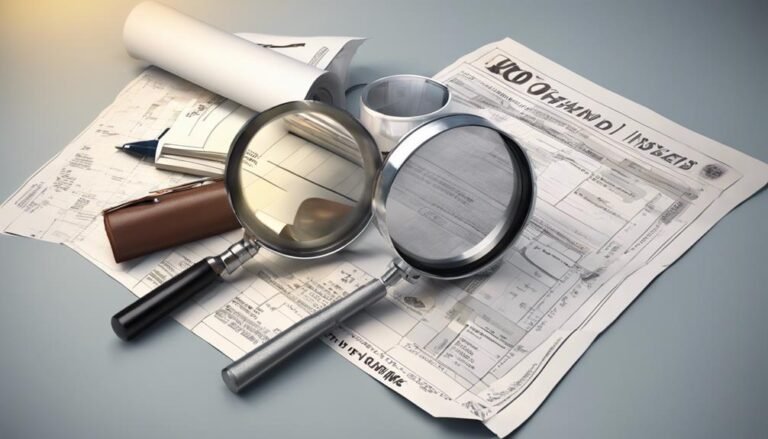Early Retirement Strategies (FIRE Movement)
To achieve early retirement with the FIRE (Financial Independence, Retire Early) movement, focus on strategic financial planning, aggressive saving, and wise investing. Set SMART goals, automate savings, and consider side hustles for extra income. Maximize retirement savings by cutting unnecessary expenses and exploring tax-efficient investments like index funds. Embrace a frugal lifestyle and prioritize building passive income streams. Overcoming challenges like healthcare costs and multiple income sources is vital. Secure a sustainable financial plan with diversified investments and regular assessments. Mastering these strategies is essential for a successful journey toward early retirement.
Key Takeaways
- Automate savings and reduce expenses to increase retirement fund contributions.
- Explore side hustles and passive income for financial independence.
- Invest in tax-efficient retirement accounts and diversify your portfolio.
- Cut unnecessary expenses through frugal living and budgeting techniques.
- Develop a sustainable withdrawal plan to maintain post-retirement lifestyle.
Understanding the FIRE Movement
To understand the FIRE Movement, it's essential to explore its core principles of financial independence and early retirement. The FIRE movement, standing for Financial Independence, Retire Early, is a lifestyle movement aimed at achieving financial independence and retiring early.
At its core, the movement emphasizes aggressive saving, frugality, and investing to reach financial independence as quickly as possible. Individuals following the FIRE movement typically aim to save a significant portion of their income, often upwards of 50% or more, to build a nest egg that can sustain them through early retirement.
Retirement strategies within the FIRE movement often involve maximizing income, minimizing expenses, and investing wisely to accelerate the path to financial independence. Common tactics include budgeting meticulously, cutting unnecessary expenses, investing in low-cost index funds, and seeking additional income streams through side hustles or entrepreneurship.
Setting Financial Independence Goals
Now, let's focus on setting your financial independence goals.
By employing goal-setting techniques and tracking your progress effectively, you can pave the way towards achieving your desired level of financial independence.
This strategic approach will help you stay motivated and on track as you work towards early retirement.
Goal-Setting Techniques
Craft clear and measurable financial independence goals to guide your early retirement planning effectively. Setting SMART goals and utilizing visualization techniques can enhance your chances of achieving financial independence sooner rather than later.
- Specific: Define your financial independence goal with precision. For example, 'I want to achieve a retirement fund of $1 million by age 45.'
- Measurable: Guarantee your goals are quantifiable. Track your progress regularly to see how close you're to reaching your target.
- Achievable: Set realistic goals that align with your income, savings rate, and investment strategy.
- Time-bound: Establish a clear timeline for achieving financial independence. For instance, 'I aim to be financially independent within the next 15 years.'
Tracking Progress Effectively
Effectively tracking your progress towards financial independence goals is vital for staying on target and adjusting your strategies as needed. To guarantee you're on the right path, regular progress tracking is imperative.
Begin by establishing clear financial milestones that align with your overall retirement objectives. These milestones act as checkpoints, allowing you to gauge how close you're to achieving financial independence.
Utilize tools such as spreadsheets, budgeting apps, or online calculators to monitor your income, expenses, savings, and investment growth. By tracking these key financial metrics consistently, you can identify any deviations from your planned trajectory early on and make timely adjustments to realign your efforts.
Set specific and measurable goals for each milestone, whether it's reaching a certain savings amount, investment portfolio size, or debt reduction target. Regularly reviewing your progress against these goals provides valuable insights into your financial health and motivates you to stay disciplined in your pursuit of early retirement.
Maximizing Savings Rate
To maximize your savings rate, focus on consistently setting aside a percentage of your income towards retirement accounts and investments. This proactive approach can accelerate your journey towards early retirement.
Here are four key strategies to help you boost your savings rate effectively:
- Automate Savings: Set up automatic transfers from your checking account to your savings or investment accounts. This guarantees that a portion of your income is saved before you have the chance to spend it.
- Reduce Expenses: Review your monthly expenses and identify areas where you can cut back. By trimming unnecessary spending, you free up more money to save towards your retirement goals.
- Increase Income: Consider taking on a side hustle or freelance work to supplement your primary income. The extra earnings can have a significant impact on your savings rate.
- Track Progress: Regularly monitor your savings rate and adjust your strategies as needed. This will help you stay motivated and on track towards your early retirement goals.
Investing for Early Retirement
When aiming for early retirement, it's vital to contemplate tax-efficient retirement investments that can help you maximize your savings.
Diversifying your investment portfolio is also imperative to guarantee long-term growth and stability.
Tax-Efficient Retirement Investments
Consider incorporating tax-efficient retirement investments into your early retirement strategy to maximize your savings and minimize tax liabilities. When planning for early retirement, it's important to optimize your investment choices within retirement accounts to minimize the tax impact and enhance your overall returns.
Here are four key strategies to help you make tax-efficient retirement investments:
- Utilize Retirement Accounts: Take advantage of tax-advantaged accounts such as 401(k)s, IRAs, or Roth IRAs to maximize your contributions and benefit from potential tax deductions or tax-free growth.
- Tax-Loss Harvesting: Implement tax-loss harvesting to offset gains in your taxable accounts with losses, reducing your overall tax burden.
- Invest in Tax-Efficient Funds: Choose low-cost index funds or exchange-traded funds (ETFs) that are tax-efficient, with minimal turnover and capital gains distributions.
- Strategic Asset Location: Place tax-inefficient investments like bonds in tax-advantaged accounts and equities in taxable accounts to optimize your tax liabilities.
Diversifying for Long-Term Growth
For achieving long-term growth in your early retirement investment portfolio, diversifying across different asset classes is essential. Portfolio diversification is a key strategy that can help manage risk and optimize returns over time. By spreading your investments across various asset classes such as stocks, bonds, real estate, and commodities, you can reduce the impact of market volatility on your overall portfolio performance.
Effective asset allocation is another critical component of diversification for long-term growth. Allocating your assets strategically based on your risk tolerance, investment goals, and time horizon can help you achieve a balanced and diversified portfolio that's well-positioned to weather market fluctuations and generate consistent returns over the years.
Remember that diversification doesn't guarantee profit or protect against loss, but it can help minimize risk and enhance your chances of achieving your long-term financial objectives.
Regularly reviewing and adjusting your asset allocation based on changing market conditions and your evolving financial goals is vital for maintaining a diversified portfolio that supports your early retirement plans.
Frugal Living Tips
Implementing cost-cutting measures and adopting a more minimalist lifestyle can be key strategies for achieving frugality and financial independence in early retirement. By incorporating budgeting tips and embracing a minimalist lifestyle, you can effectively manage your expenses and increase your savings.
Here are some frugal living tips to help you on your journey:
- Create a Detailed Budget: Track your income and expenses meticulously to identify areas where you can cut back and save more money.
- Practice Smart Shopping: Look for discounts, buy in bulk, and compare prices to get the best deals on your purchases.
- Engage in DIY Projects: Instead of hiring professionals for every task, consider doing some projects yourself to save on labor costs.
- Prioritize Value Over Price: Invest in quality items that last longer, even if they come with a higher upfront cost, to avoid frequent replacements.
Side Hustles and Passive Income
To further bolster your financial stability and increase your income streams, exploring side hustles and passive income opportunities can be a strategic move towards achieving early retirement goals. Side hustle ideas encompass a wide range of possibilities, such as freelance work, consulting, online tutoring, or selling handmade crafts. These ventures can provide additional income while allowing flexibility in your schedule.
Passive income opportunities, on the other hand, involve earning money with minimal effort on your part, like rental properties, dividend-paying stocks, or creating digital products. Financial independence through side hustles and passive income is a key pillar of the FIRE (Financial Independence, Retire Early) movement.
By diversifying your income sources, you can build resilience against economic downturns and job loss. Side hustles and passive income streams can accelerate your journey to retirement by increasing your savings rate and creating a more sustainable financial future.
Consider exploring various side hustle ideas and passive income opportunities to strengthen your financial position and work towards early retirement.
Managing Expenses Effectively
Effectively managing expenses is crucial for achieving your early retirement goals and maintaining financial stability. To make sure you're on the right track, here are some key strategies to help you cut expenses and improve your budgeting skills:
- Track Your Spending: Start by analyzing your current expenses to identify areas where you can cut back. Use apps or spreadsheets to monitor where your money is going.
- Create a Detailed Budget: Develop a thorough budget that outlines your income and expenses. Allocate funds for necessities first, then prioritize saving and investing.
- Reduce Discretionary Spending: Evaluate your discretionary expenses such as dining out, shopping, or entertainment. Consider limiting these expenses to redirect more funds towards your retirement goals.
- Negotiate Bills and Expenses: Don't hesitate to negotiate with service providers for better rates or explore alternative options to reduce monthly bills. From insurance premiums to subscription services, there may be room for savings by being proactive.
Retiring Early: Challenges and Solutions
Successfully retiring early presents both financial challenges and strategic solutions that require careful planning and execution. Some retirement challenges include ensuring a sustainable income stream for an extended period, managing healthcare costs, and dealing with unexpected expenses.
To overcome these early retirement obstacles, consider creative solutions such as building multiple income streams through investments, rental properties, or freelancing to diversify your revenue sources. Additionally, optimizing your healthcare coverage by exploring high-deductible health plans paired with health savings accounts can help mitigate healthcare expenses.
Creating an emergency fund specifically earmarked for unforeseen costs can provide a safety net in times of financial strain. In addition, developing a detailed budget and regularly reviewing your spending habits can help identify areas where you can cut back, thereby increasing your savings rate.
Creating a Sustainable Early Retirement Plan
Addressing the financial challenges and strategic solutions discussed in the previous section, creating a sustainable early retirement plan requires careful consideration and proactive decision-making. To guarantee a stable financial future post-retirement, you need to focus on several key areas:
- Retirement Withdrawal Strategy: Establish a systematic approach for withdrawing funds from your retirement accounts to sustain your lifestyle without depleting your savings too quickly.
- Diversified Investment Strategies: Allocate your assets across a variety of investment vehicles to mitigate risk and maximize returns over the long term.
- Regular Financial Health Assessments: Continuously monitor and reassess your financial situation to adapt to changing market conditions and personal needs.
- Emergency Fund Planning: Set aside a separate fund to cover unexpected expenses or financial downturns, ensuring your retirement accounts remain untouched and intact for the long haul.
Frequently Asked Questions
Can I Retire Early if I Have Debt?
You can retire early with debt by focusing on debt management, budgeting, and retirement planning. Prioritize paying off high-interest debts, create a solid budget, and work towards financial independence to achieve your early retirement goals.
How Do Taxes Impact Early Retirement Savings?
Wondering how taxes affect your early retirement savings? Tax implications can impact your retirement accounts differently. Understanding tax advantages of accounts like IRAs and 401(k)s can help optimize your savings strategy.
Is Early Retirement Feasible for Single Parents?
For single parents, early retirement can be feasible with careful financial planning. Childcare challenges may require creative solutions, support systems are vital, and maintaining work-life balance is key. It's about balancing responsibilities with long-term goals.
What Role Does Healthcare Play in Fire?
When it comes to early retirement and managing finances, healthcare affordability is a critical factor. Understanding insurance options and planning for medical expenses is essential for a secure retirement, ensuring you have proper coverage without draining your savings.
Can I Still Enjoy Travel in Early Retirement?
Picture early retirement as a vast canvas awaiting your brush strokes of adventure. With retirement flexibility, craft a travel budget that lets you explore. Maximize travel rewards, apply budgeting tips, and savor the world.
Conclusion
To sum up, achieving early retirement through the FIRE movement is possible with strategic planning and dedication.
Did you know that according to a recent study, 70% of FIRE movement participants are able to retire in their 40s?
By setting financial independence goals, maximizing savings, and investing wisely, you can work towards retiring early and living the life you desire.
Start implementing these strategies today and pave the way for a financially secure future.








